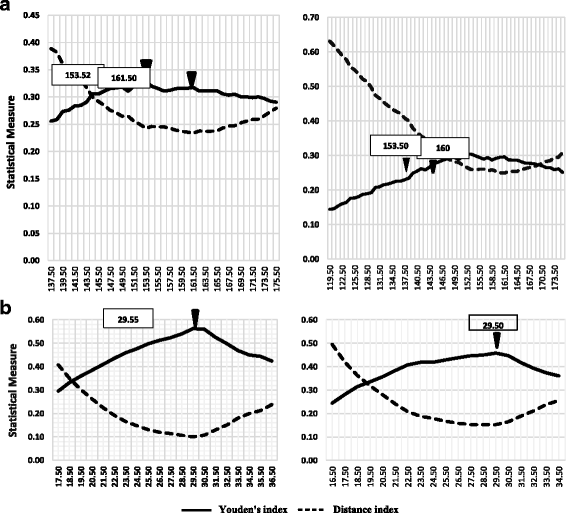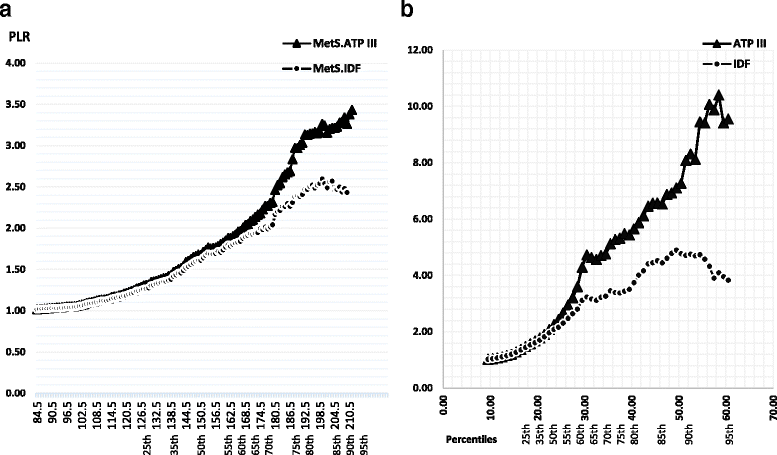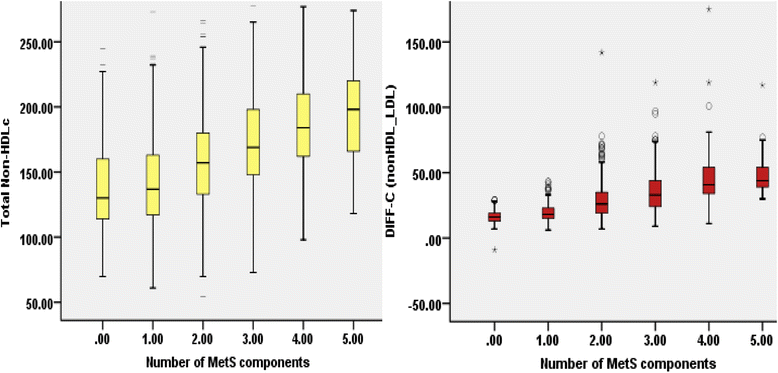Non-high-density lipoprotein fractions are strongly associated with the presence of metabolic syndrome independent of obesity and diabetes: a population-based study among Iranian adults
- PMID: 28596946
- PMCID: PMC5463311
- DOI: 10.1186/s40200-017-0306-6
Non-high-density lipoprotein fractions are strongly associated with the presence of metabolic syndrome independent of obesity and diabetes: a population-based study among Iranian adults
Abstract
Background: Non-HDL-C as a valuable predictor of premature atherosclerosis, coronary events like first Myocardial infarction and cardiovascular mortality has a high accuracy of measurement both in fasting and non-fasting individuals. Metabolic syndrome (MetS) can promote the development of diabetes mellitus, endothelial dysfunction and atherosclerosis. A common pathway for cross linking of metabolic abnormalities and non-HDL-C has been suggested. In this study we aimed to describe the potential association between non-HDL cholesterol fractions and metabolic syndrome.
Methods: Data of third national surveillance of the risk factors of non-communicable diseases (SuRFNCD-2007) were analyzed. We defined metabolic syndrome (MetS) according to the Adult Treatment Panel III (ATPIII) and International Diabetes Federation (IDF) criteria for 2125 subjects aging 25-64 years. The receiver operating characteristic (ROC) curves were used to determine the optimal cut-points for the diagnosis of MetS. The curves were depicted for non-high-density lipoprotein cholesterol (non-HDL-C) and difference of total non-HDL-C and LDL-C (Differential cholesterol or Diff-C) as predictors of MetS. Logistic regression was also performed in a complex sample analysis scheme.
Results: The area under the curve (AUC) with 95% Confidence intervals of total non-HDL-C was computed. Values were 0.693 (0.670-0.715) for IDF-defined MetS and 0.719 (0.697-0.740) for ATPIII criteria. The optimal non-HDL-C cut-point we recommend for both criteria is 153.50 mg/dl (sensitivity: 75.7%, specificity: 57.2%, with ATPIII; sensitivity: 73.2%, specificity: 57.1%, with IDF). Using IDF criteria, the accuracy of predictors were greater in non-diabetic subjects. AUC of Diff-C in DM (-) vs. DM (+) were 0.786 (0.765-0.807) vs. 0.627(0.549-0.705). Adults with high non-HDL-C were 4.42 times more likely to have ATPIII-defined MetS (≥190 vs. < 190 mg/dL). Elevated Diff-C corresponded to increased risk of the MetS (ORs: 10.71 and 26.29 for IDF and ATP III criteria, respectively. All P-values <0.001).
Conclusions: A significant robust association exists between non-HDL-C and MetS whether applying conventional or new thresholds.
Keywords: Cut-points; Diabetes mellitus; Metabolic syndrome; Non-HDL cholesterol; SuRFNCD-2007.
Figures





Similar articles
-
Are non-high-density lipoprotein fractions associated with pediatric metabolic syndrome? The CASPIAN-V study.Lipids Health Dis. 2018 Nov 14;17(1):257. doi: 10.1186/s12944-018-0895-1. Lipids Health Dis. 2018. PMID: 30428934 Free PMC article.
-
Optimal cut-off of homeostasis model assessment of insulin resistance (HOMA-IR) for the diagnosis of metabolic syndrome: third national surveillance of risk factors of non-communicable diseases in Iran (SuRFNCD-2007).Nutr Metab (Lond). 2010 Apr 7;7:26. doi: 10.1186/1743-7075-7-26. Nutr Metab (Lond). 2010. PMID: 20374655 Free PMC article.
-
Is non-high-density lipoprotein associated with metabolic syndrome? A systematic review and meta-analysis.Front Endocrinol (Lausanne). 2022 Sep 13;13:957136. doi: 10.3389/fendo.2022.957136. eCollection 2022. Front Endocrinol (Lausanne). 2022. PMID: 36176470 Free PMC article.
-
Leptin cut-off values for determination of metabolic syndrome: third national surveillance of risk factors of non-communicable diseases in Iran (SuRFNCD-2007).Endocrine. 2011 Aug;40(1):117-23. doi: 10.1007/s12020-011-9447-4. Epub 2011 Mar 8. Endocrine. 2011. PMID: 21384232
-
Prevalence of Metabolic Syndrome and Its Components in the Iranian Adult Population: A Systematic Review and Meta-Analysis.Iran Red Crescent Med J. 2015 Dec 27;17(12):e24723. doi: 10.5812/ircmj.24723. eCollection 2015 Dec. Iran Red Crescent Med J. 2015. PMID: 26756015 Free PMC article. Review.
Cited by
-
HDL-C and non-HDL-C levels are associated with anthropometric and biochemical parameters.J Vasc Bras. 2019 Apr 1;18:e20180109. doi: 10.1590/1677-5449.180109. eCollection 2019. J Vasc Bras. 2019. PMID: 31312214 Free PMC article.
-
Non-HDL cholesterol and long-term follow-up outcomes in patients with metabolic syndrome.Lipids Health Dis. 2023 Oct 4;22(1):165. doi: 10.1186/s12944-023-01923-y. Lipids Health Dis. 2023. PMID: 37794473 Free PMC article.
-
Remnant cholesterol can identify individuals at higher risk of metabolic syndrome in the general population.Sci Rep. 2023 Apr 12;13(1):5957. doi: 10.1038/s41598-023-33276-y. Sci Rep. 2023. PMID: 37045908 Free PMC article.
-
Novel and traditional lipid profiles in Metabolic Syndrome reveal a high atherogenicity.Sci Rep. 2019 Aug 13;9(1):11792. doi: 10.1038/s41598-019-48120-5. Sci Rep. 2019. PMID: 31409878 Free PMC article.
-
Are non-high-density lipoprotein fractions associated with pediatric metabolic syndrome? The CASPIAN-V study.Lipids Health Dis. 2018 Nov 14;17(1):257. doi: 10.1186/s12944-018-0895-1. Lipids Health Dis. 2018. PMID: 30428934 Free PMC article.
References
-
- Cobbaert C, Jukema JW, Zwinderman AH, et al. Modulation of lipoprotein (a) atherogenicity by high density lipoprotein cholesterol levels in middle-aged men with symptomatic coronary artery disease and normal to moderately elevated serum cholesterol. Regression growth evaluation Statin study (REGRESS) study group. J Am Coll Cardiol. 1997;30:1491. doi: 10.1016/S0735-1097(97)00353-7. - DOI - PubMed
LinkOut - more resources
Full Text Sources
Other Literature Sources

